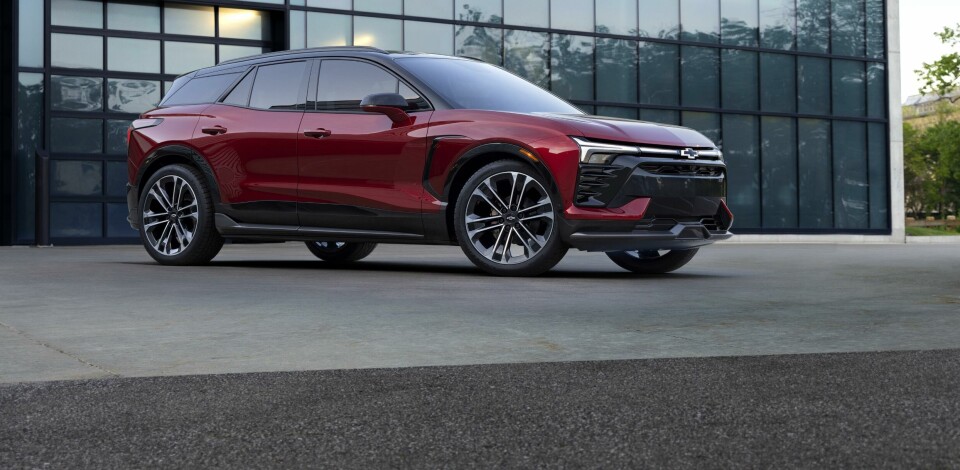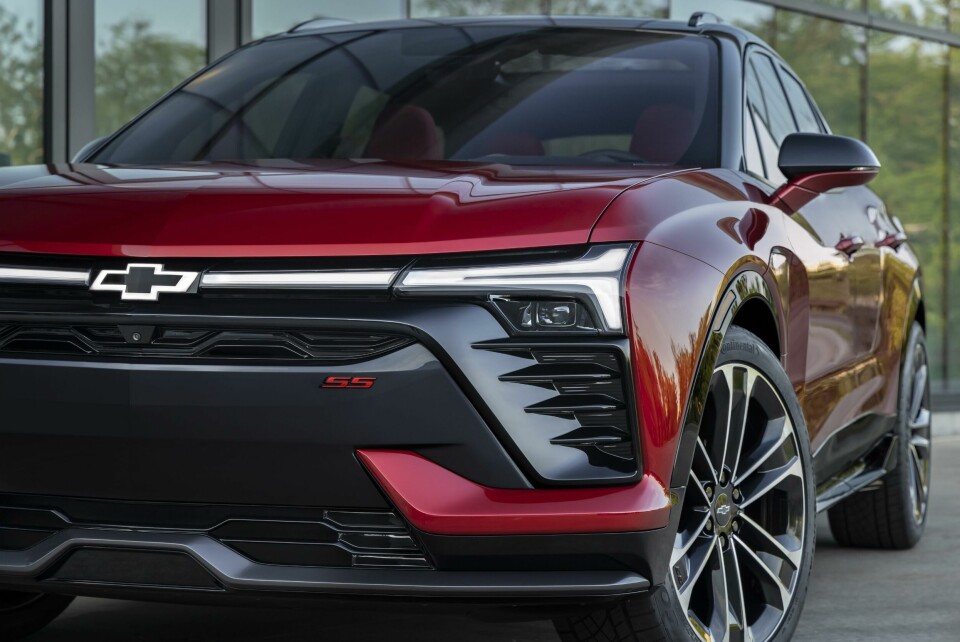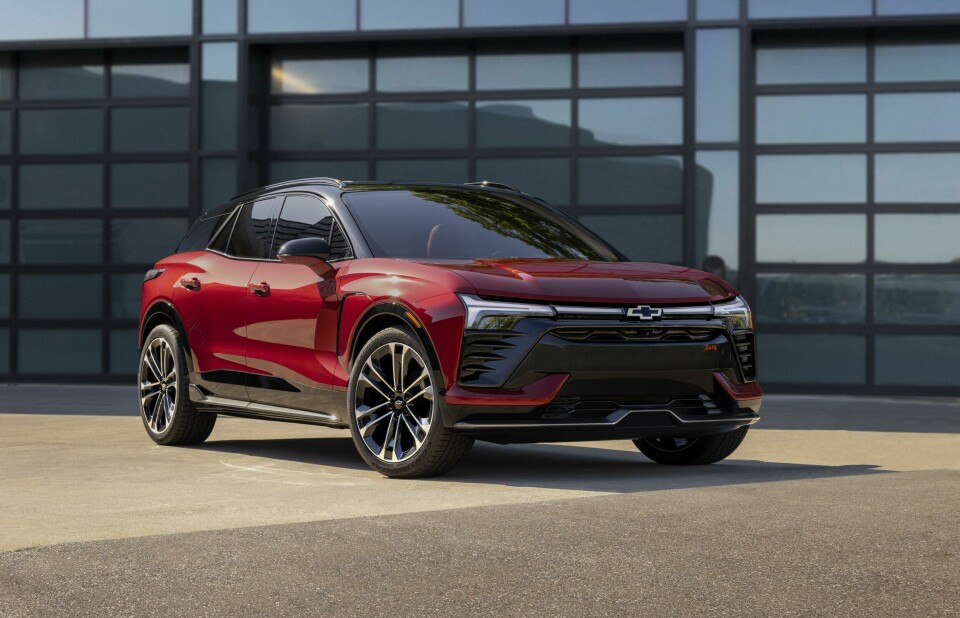
Chevrolet debuts the 2023 Blazer EV
Like the recently reborn Hummer, General Motors has taken another iconic nameplate electric. Car Design News caught up the designers of the new Chevrolet Blazer EV
Once known as a rugged, petrol-burning SUV, the newest Blazer has gone electric. The nameplate, resurrected as a two-row ICE crossover in 2019, is the latest in a lineup built on GM’s Ultium BEV platform which underpins the GMC Hummer, Cadillac Lyriq, and other forthcoming models.
Aimed at petrolheads, not techies, the Blazer boasts aggressive proportions and design cues borrowed from Chevrolet’s iconic Camaro and Corvette. Ahead of the reveal in Los Angeles, we spoke with creative exterior design Raphael Molina and creative interior designer Justin Salmon to get the lowdown on the new BEV.
Car Design News: How did the design team approach the Blazer’s shift to electrification? What were the underlying goals?
Raphael Molina: Given this is an electric platform, we felt it was naturally poised to live in this low, wide, profile. The last-generation Blazer looked more like a performance vehicle, so this was just another chance to amplify all of that. We wanted to do something that could stand out in this segment and look more purposeful and in terms of performance and attack a different spectrum of customers.
Justin Salmon: We were trying to pull from our performance heritage, and we wanted that to be infused into our DNA. We had a lot of dialogue in the studio when we were kicking things off about how sporty versus how techie we wanted the interior to feel. Those keywords tend to live on different sides of the spectrum. We didn’t want it to feel like a cold appliance, so we ended up tipping the needle closer to the sporty side of things. But the way we executed the tech details gives you that refinement without sacrificing the emotional side of things.

CDN: How did that manifest in the resulting design?
RM: At Chevrolet we have plenty of sources of inspiration, and we took details from the Camaros and the Corvettes, especially on the lighting and the exterior.
The number one thing, of course, is proportions. We wanted to maximise the dash-to axle ratio, like performance vehicles have, even though it’s not necessary for a BEV. And as we have such a long wheelbase, we have enough room to do that without sacrificing space.
When it comes to lighting, we have this very consistent dual element in the front and rear. Then for the body theme, we took these conversion and diversion lines and repeated them. So it’s the same idea in every corner of the vehicle. If you look at Corvette, Camaro, they have this dual-blade element, so we took that up a notch and made it a little more prominent on the rear. Across the front it’s also fully cross-lit, including the badge, so that’s something that will make the car stand out at night, be a recognisable brand cue, and then why not have that same dwelling element on the side, so you’ll see those two main lines on the body side.
“I love how our lighting team worked to create lighting choreography… It’s a key branding element”
CDN: In this time when traditional front grille openings aren’t needed on BEVs, many brands still debate how to maintain a recognisable front face. How was this done on the Blazer?
RM: Ten years ago the grille was a huge element of how you tell your brand apart, but now lighting has to step up to the plate. And that’s why we made the lighting the same signature front and back. Then in front we get this cross-lit bar with the badging, and since that takes center stage, you get to have a grille that’s truly not a grille, we get to do full shape, which we all love, and beautiful color break-up that has some interest (and of course can hide all of the necessary sensors since this vehicle will come optional with Super Cruise, GM’s hands-free driver assist system).
JS: I love how our lighting team worked to create lighting choreography because it’s a key branding element. But it also gives the customer information, communicating charging status through the speed and intensity of the lighting, as well as a greeting when you walk up.
CDN: How does the top-of-the-line SS model differ from the other trims?
RM: The SS is our sportiest of all the trim levels. We have a unique front fascia with all this aggressiveness, it looks very blacked out and very serious. It’s got the ground effects and side spoiler as well as different lower fascia and 22-inch wheels. There are also no fake grilles.
CDN: Let’s talk HMI. The Blazer EV has a cockpit-style layout, with a horizontal display tilted toward the driver, as opposed to a portrait-style tablet display seen on so many BEVs right now. How did the team decide on this design?
JS: We knew we wanted the interior to have a really high-tech first impression. The team did a fantastic job with ergonomic studies to make sure the sweep of it felt fantastic. With that slight orientation toward the driver, some of that plays into our performance heritage; you’ll see more severe angles in the Corvette for example. With the 17.7-inch centre display, the way it’s configured is also very thoughtful. Rather than searching down vertically into the console, there’s a very eyes-on-the road approach. We wanted to keep things front-and-centre.
The components team also did a great job with the tactile things like volume and HVAC. There’ll be redundancies in the screen but we’re hearing our customers loud and clear on allowing them to adjust those manually. Then looking beyond at some of the form language, you’ll see some really dramatic surfacing happening through the IP, and that really lends itself to supporting this display strategy. These screens are also standard on all trim levels, which is something we’re very proud of.
“Round shapes have always been a signature element for Chevrolet performance. We wanted to elevate that to another level”
CDN: What was the thinking behind the colour and trim options and what are some specific examples?
JS: On this vehicle you can create really distinct personas between trim levels. The SS that we’re sitting in with the adrenaline red and black two-tone interior is really bold, but we’ll have some more understated options as well. In the RS you’ll see a more monochromatic approach. The two-shot execution on the trim (a textured material beneath a clear layer) really plays up our focus on translucence and authenticity, just letting the shapes beneath show through.
The pattern on the speaker grilles and charging pad in the centre console. You’ll definitely see us dipping into darker and more sophisticated color spaces, more tone-on-tone, and then really focusing on the accent of the stitching, and we’ll roll out some more details closer to launch.
CDN: Tell us more about those cool turbine-shaped air vents.
JS: The round shapes have always been a signature heritage element for Chevrolet performance. We really wanted to find a way to elevate that to another level. Really playing with the material interactions, we’re celebrating those refined details but leveraging the translucency of the material to create a new effect. The available ambient lighting will really highlight the inner details of that. By the way, the flat-bottomed steering wheel also plays into our performance pedigree and is something we’re very excited about.
CDN: Because this vehicle is aimed more toward traditional Blazer and ICE crossover customers and not early-adopter types, how would you reassure red-blooded, gas-burning Americans to switch?
RM: As we went to electric, there was this conservative approach where people felt like EVs were more of an electronic device than a real animal like a combustion car. But there’s this underlying theme with this car where it knows you. You walk up to it and it lights up, it starts up without a key or button, the deck lid opens with a proximity sensor. So in a way it feels much more alive than a combustion vehicle ever did.
JS: Our aim was something that would feel very dramatic, not something that felt like someone just stepped into an appliance. There’s a heritage there, there’s a heartbeat, and there are elements that draw on the past. These are things that have been a success with our performance vehicles and I think keying into that ethos is going to be successful for the Blazer EV.


















